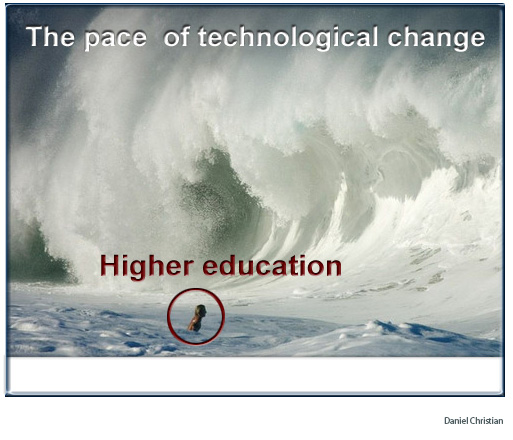YouTube is 5 years old! — from Jane Hart
From DSC:
Wow…5 years is not traditionally a long time; look at what has occurred in these last 5 years! Man…YouTube is but one example.
YouTube is 5 years old! — from Jane Hart
From DSC:
Wow…5 years is not traditionally a long time; look at what has occurred in these last 5 years! Man…YouTube is but one example.
From DSC:
In an assignment for a class last week, I ran across a time-saving tool offered via timetoast.com. If you want to put together interactive timelines — without having to know programming languages or scripting languages — you might be interested in kicking the tires on this web-based tool. As an example, I was able to put together the following timeline of instructional media* in an hour or so:
Further reflections on this from DSC:
So what am I saying here?
I’m saying that we are used to using/hearing/seeing audio, video, interactivity, multi-directional communications because of these technologies. They cultivated the ground for people using the technologies that we are:
So when we employ highly-powerful, multimedia-based, educationally-beneficial items on the Net today — when we contribute podcasts, vodcasts, lectures, exercises, animations, etc. to the Net — we can thank these technologies for being the technological ancestors in the tech-family tree. They really didn’t disappoint after all. They were the seeds that were planted over time to create a wonderful harvest….a very powerful communications network…the most powerful one the world has ever known. Not bad for 100 years.
* Based upon article by Robert Reiser:
Reiser, R. (2001). A history of instructional design and technology: Part I: A history of instructional media. ETR&D. Vol. 49(1). pp. 53-64.
**As Jesus once responded when asked about why his disciples didn’t fast, he replied:
16“No one sews a patch of unshrunk cloth on an old garment, for the patch will pull away from the garment, making the tear worse. 17Neither do men pour new wine into old wineskins. If they do, the skins will burst, the wine will run out and the wineskins will be ruined. No, they pour new wine into new wineskins, and both are preserved.”
These technologies created the environment…the proper wineskins…to lay the foundation for the “new wine” to be poured into our worlds without this new wine “running out” and ruining the wineskins. Can you imagine if someone had been able to introduce these technologies within 10-20 years…would they have taken? Given human nature, I doubt it. The wineskins took time to change. The thing is, the pace of change is quickening and is increasingly more difficult to keep up with.
I wonder…will the current wineskins hold? Or are our wineskins now very used to this pace of change?
From ICT integration to systemic transformation — from elearnspace by George Siemens
“I’m in Madrid, delivering a presentation on moving from ICT integration to systemic transformation. Spain currently has the EU Presidency and they’ve made education a core focus. Slides are available on slideshare.”
Graphics below from DSC: The graphic above shows the dramatic increase in the pace of technological adoption/change. The graphics below point to that same pace of change…can you hear the engines on the track? Can you hear the pounding waves hitting the shoreline?


Canada: ‘New workplace order’ looms as boomers head to retirement — from The Official ASTD Blog by Ann Pace
The Canadian workforce is the most culturally diverse and dynamic in the world. There is much to be gained by utilizing everyone to their full potential, but the blinding speed with which the workplace is changing requires flexibility on the part of employers (emphasis DSC).
The looming retirement of the baby boomer generation is a key development. With more than a third of the entire labour force preparing to retire over the next two decades or so, this represents one of the most significant shifts in the workplace seen in the last half-century. Employers will be faced with labour force growth that will slow to a crawl and they will need to find new and innovative ways of utilizing Canada’s current labour pool.
For more information on generations and diversity in the workplace, consider attending the session Relevant Diversity Dimensions Levels for More Effect D&I Management at the ASTD 2010 International Conference and Exposition!
Disruptive Innovation in the Classroom — from The Journal by Bridget McCrea
One expert discusses how disruptive innovations like online learning will change the way students learn and progress.
From DSC:
I am not sure we are fully appreciating the scope of the changes about to take place throughout higher education. If we look at what the Internet has done to other industries — and the corresponding (amazingly-short) timeframes it took to turn those industries on their heads — we will begin to have a better appreciation for the massive changes coming down the pike. When the iPod was introduced in October 2003, it didn’t take Apple long to completely dominate the music distribution business. Also, take a look at journalism and how quickly things have changed there (relatively speaking). I believe higher education is next. For more background on my stance on things, you might want to check out two pages/presentations: